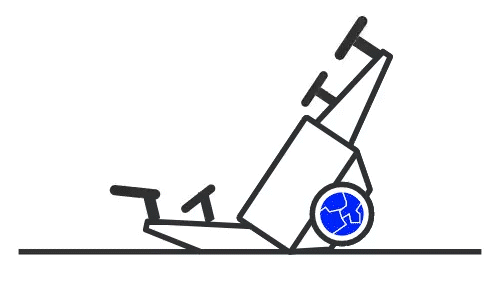He finally got the company drone back.
It was broken beyond repair from the crash.
No humans, animals, or buildings were harmed. But his confidence was broken and fear crept up as he wondered how he would pay to replace the drone.
Eventually, Mike (*not his real name) dusted himself off, told his boss what happened, and tried to move on.

You’re still the pilot
Mike and a couple friends were in Miami for a conference and decided to fly their company drones around town that night. Noticing a beautiful statue lit up by floodlights, Mike put his drone on an automatic flight path to capture some photos.
Unfortunately, the automatic flight path didn’t notice a dark wall shaded by the night, and the drone crashed into the building, falling onto the parking lot roof below. He tried to switch to manual-control flying before the crash, but couldn’t do it fast enough. He asked the security guard at the building to help him retrieve his drone, which resulted in the multi-level climb down emergency ladders onto the muddy parking lot roof.
Then he called his boss to tell him what happened.
What to do when you crash the company drone
Before the call, Mike was worried about how his boss would react. He was also terrified at the possibility of having to replace the drone personally – he didn’t have a spare $2,000 lying around. But he made the call anyway.
His boss outlined the immediate next steps, some of which Mike had already done:
1. Check for injuries (human + animal) and damage (property): Luckily, nothing and no one was hurt because the drone hit a brick wall and fell onto a parking lot roof.

2. Collect your drone and troubleshoot if it can be saved: Not all drone crashes ruin the drone completely, though in Mike’s case that’s what happened.
3. Tell relevant stakeholders: In this case, the only stakeholder who needed to know was the boss. In other cases, especially if the drone isn’t a write-off, you’ll likely need to alert whomever on your team handles tech support for drones.
4. Confirm warranties and insurance vs. write-off costs: Check what kind of support you have (for instance, DJI Care for DJI drones) to see if the repair costs will be covered by warranty or insurance.
Easy ways to not crash a drone in the future
Mike’s boss was trying to be as fair as possible, but she was also pretty annoyed that this happened in the first place. To ensure it didn’t happen again, she worked with Mike to enact some policies.
Policies and guidelines:
-
No flying company drones for personal use.
-
No flying company drones at night (unless for a pre-authorized work-related reason).
-
No flying company drones in a city or between densely packed buildings (unless in the daytime for a work project).

Practice and (more) practice:
-
Encouraging people to practice automated flight paths in controlled environments (such as open fields) to get used to them.
-
Practicing stopping automatic flight paths and taking manual control of the drone quickly (to use in case of an emergency).
-
Encouraging new drone users to buy their own drone, if feasible – usually a much less expensive personal-size drone – so they can practice as often as they’d like.
Covering genuine accidents:
-
Purchase extended warranties or insurance for drones.
-
Have additional drones at the ready so surveyors aren’t held back by a genuine accident.
A drone crash is not the end of the world. Yes, it’s an expensive piece of machinery, but accidents happen. The key is to have the right policies and procedures in place to eliminate unnecessary crash risks and mitigate any issues arising from genuine accidents. In this way, a drone is just like any other piece of hardware – it’s critical for the job and should be treated as such.






